

Scientia Silvae Sinicae ›› 2020, Vol. 56 ›› Issue (9): 30-39.doi: 10.11707/j.1001-7488.20200904
Previous Articles Next Articles
Yalan Gao,Yuanhao He,He Li*
Received:2020-01-05
Online:2020-09-25
Published:2020-10-15
Contact:
He Li
CLC Number:
Yalan Gao,Yuanhao He,He Li. Biological Function bZIP-Type Transcription Factor CfAp1 in Colletotrichum fructicola[J]. Scientia Silvae Sinicae, 2020, 56(9): 30-39.
Table 1
Primers used in this study"
| 引物 Primer | 引物序列 Sequence (5’→3’) |
| bZIP45-1F | CAGTTCACACACACTGGTCA |
| bZIP45-2R | TTGACCTCCACTAGCTCCAGCCAAGCCTGCGAAGAGTACGTGAAGGG |
| bZIP45-3F | CAAAGGAATAGAGTAGATGCCGACCGAGGACCCGACGTCTCCATGT |
| bZIP45-4R | GCATGTTTCCAGCAGCATCA |
| bZIP45-5F | AGTCGAACATGACGGCTGAC |
| bZIP45-7F | CAAAGGATGCGAACAGCGAG |
| bZIP45-8R | AACTAGGACCGGCATTCGAC |
| bZIP45-9F | ACTCACTATAGGGCGAATTGGGTACTCAAATTGGTTAGTCTCGTCCTTGGGTCTTGG |
| bZIP45-10R | CACCACCCCGGTGAACAGCTCCTCGCCCTTGCTCACGGCCTTTGTCTTGTTCTGGGC |
| H855R | GCTGATCTGACCAGTTGC |
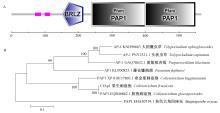
Fig.1
Domain prediction and phylogenetic analysis of CfAp1 A: The structure of CfAp1 was predicted using the SMART website (http://smart.embl-heidelberg.de/); BRLZ: basic-leucine zipper domain; the number represents the serial number of the amino acid. B: The phylogenetic tree was constructed using the neighbour-joining (NJ) method and analysed with 1 000 bootstrap replicates in Mega7.0; the number on the branch is the support calculated with 100 bootstrap replicates in the NJ analysis; the scale bar indicates the branch length. The number in front of each reference taxon is GenBank accession number of amino acid sequence orthologous to CfAp1. "

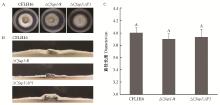
Fig.3
Growth of CfAP1 gene-deletion mutants A: The wild-type strain (CFLH16), ΔCfap1-8, and complemented strains were inoculated on PDA media and cultured at 28 ℃ in the dark for 3 days. B: Colony side views are displayed. C: Statistical analysis of the colony diameter variations. Error bars are standard deviation and the same capitals represent no significant difference on P>0.05. "


Fig.5
Oxygen stress sensitivity test of CfAP1 gene-deletion mutants A: The wild-type strain (CFLH16), ΔCfap1-8, and complemented strains were inoculated on PDA plates containing 0、2.5 and 5 mmol·L-1 H2O2, respectively. B: Statistical analysis of the inhibition rate of the indicated strains on different stressors. Error bars are standard deviation and different lowercases represent significantly difference at P≤0.01. "
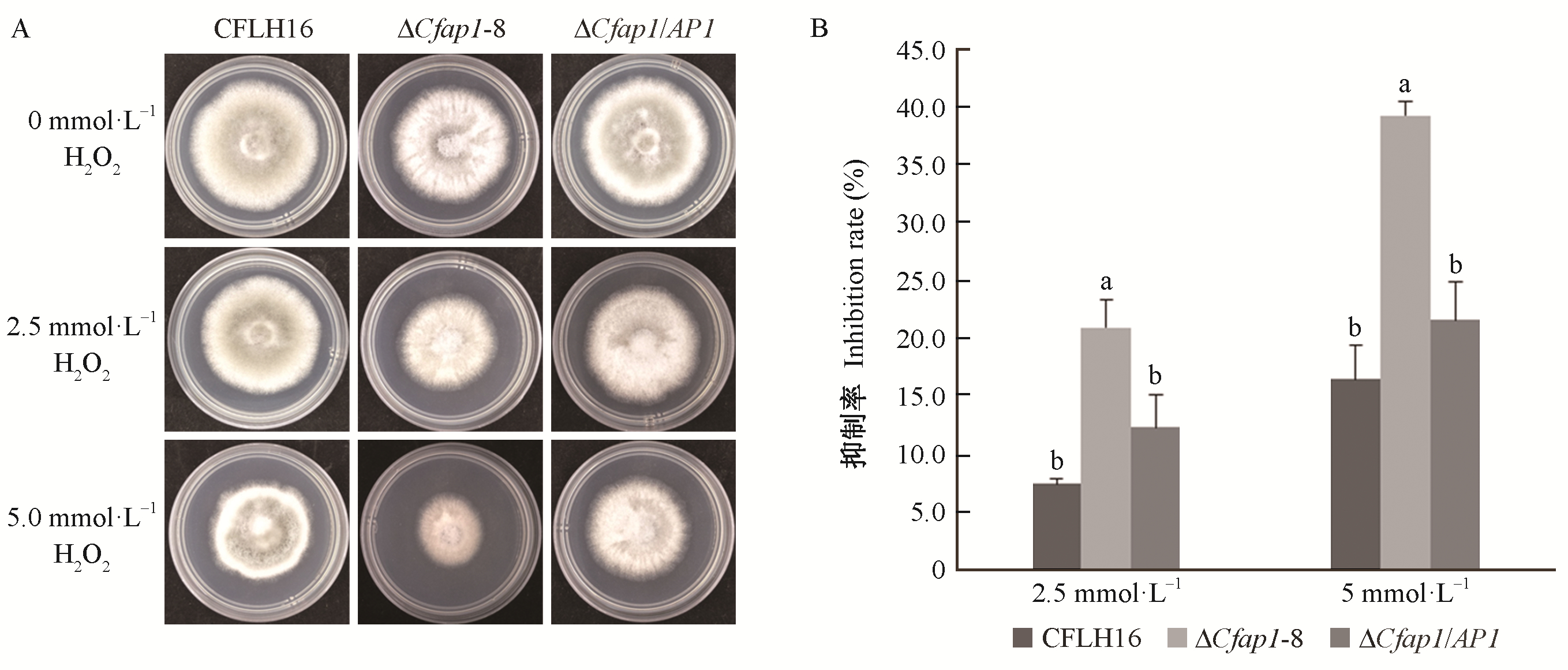

Fig.6
Osmotic sensitivity test of CfAP1 gene-deletion mutants A: The wild-type strain (CFLH16), ΔCfap1-8, and complemented strains were inoculated on PDA plates containing 0.7 mol·L-1 NaCl. B: Statistical analysis of the inhibition rate of the indicated strains on different stressors. Error bars are standard deviation and different lowercases represent significantly difference at P < 0.01. "

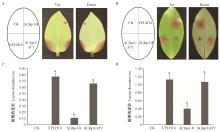
Fig.7
Pathogenicity of CfAP1 gene deleted mutants to oil-tea leaves A and B: the wild type strain CFLH16, CfAP1 deletion mutant and the complemented strains were inoculated unwounded leaves and on wounded leaves; C: Statistical analysis of the disease lesion size of wounded leaves; D: Statistical analysis of the disease lesion size of unwounded leaves. Error bars are standard deviation and different lowercases represent significantly difference at P≤0.01. "

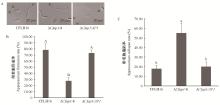
Fig.8
Appressorium in CfAP1 gene deleted mutants A:The CfAP1 gene deletion mutant can form a small amount appressorium; B: Statistical analysis of the rate of appressorium formation on glass surface; C:Appressorium collapse rate. Error bars are standard deviation and different capitals represent significantly difference at P≤0.05, different lowercases represent significantly difference at P≤0.01. "

| 陈绍红, 孙思, 王军. 14种杀菌剂对油茶炭疽病的防治研究. 广东林业科技, 2007. 22 (2): 42- 45. | |
| Chen S H , Sun S , Wang J . Study on control of anthracnose of Camellia oleifera by 14 fungicides. Guangdong Forestry Science and Technology, 2007. 22 (2): 42- 45. | |
| 陈永忠, 罗健, 王瑞, 等. 中国油茶产业发展的现状与前景. 粮食科技与经济, 2013. 38 (1): 10- 12. | |
| Chen Y Z , Luo J , Wang R , et al. Present situation and prospect of oil tea industry in China. Grain Science and Technology and Economy, 2013. 38 (1): 10- 12. | |
| 靳爱仙, 周国英, 李河. 油茶炭疽病的研究现状、问题与方向. 中国森林病虫, 2009. 28 (2): 27- 31. | |
| Jin A X , Zhou G Y , Li H . Progress problem and prospect of oil camelliae anthracnose (Colletotrichum gloeosporioides) research. Forest Pest and Disease, 2009. 28 (2): 27- 31. | |
| 李河, 周国英, 徐建平, 等. 一种油茶新炭疽病原的多基因系统发育分析鉴定. 植物保护学报, 2014. 41 (5): 602- 607. | |
| Li H , Zhou G Y , Xu J P , et al. Pathogen identification of a new anthracnose of Camellia oleifera in China based on multiple-gene phylogeny. Journal of Plant Protection, 2014. 41 (5): 602- 607. | |
| 李河, 李杨, 徐建平, 等. 海南省油茶及其他寄主植物果生刺盘孢菌群体遗传结构分析. 林业科学, 2016. 52 (10): 80- 88. | |
| Li H , Li Y , Xu J P , et al. Population genetic structure of Colletotrichum fructicola from oil tea and other host plants in Hainan province. Scientia Silvae Sinicae, 2016. 52 (10): 80- 88. | |
| 李河, 李杨, 蒋仕强, 等. 湖南省油茶炭疽病病原鉴定. 林业科学, 2017. 53 (8): 43- 53. | |
| Li H , Li Y , Jiang S Q , et al. Pathogen of oil-tea trees anthracnose caused by Colletotrichum spp. in Hunan Province. Scientia Silvae Sinicae, 2017. 53 (8): 43- 53. | |
| 李河. 2018.油茶炭疽病菌群体遗传及MAPK基因CfPMK1功能研究.长沙:中南林业科技大学博士论文, 73-76. | |
| (Li H.2018. Population genetic analyses of the fungal pathogen Colletotrichum on tea-oil trees in China and characterization of a MAPK gene CfPMK1 in the pathogen. Changsha: PhD thesis of Central South University of Forestry and Technology, 73-76.[in Chinese]) | |
| 李河, 李司政, 王悦辰, 等. 油茶苗圃炭疽病原菌鉴定及抗药性. 林业科学, 2019. 55 (5): 85- 94. | |
| Li H , Li S Z , Wang Y C , et al. Identification of the pathogens causing anthracnose of Camellia oleifera in nursery and their resistence to fungicides. Scientia Silvae Sinicae, 2019. 55 (5): 85- 94. | |
| 许俊道. 茶油的保健功能与开发前景. 中国果菜, 2018. 38 (10): 41- 43. | |
| Xu J D . Health care function and development prospect of Camellia oil. China Fruit Vegetable, 2018. 38 (10): 41- 43. | |
| 姚权, 郭源, 魏丰园, 等. bZIP转录因子CfHac1参与调控果生刺盘孢菌的生长发育和致病力. 菌物学报, 2019. 38 (10): 1643- 1652. | |
| Yao Q , Guo Y , Wei F Y . A bZIP-type transcription factor CfHac1 is involved in regulating development and pathogenesis in Colletotrichum fructicola. Mycosystema, 2019. 38 (10): 1643- 1652. | |
| 张俊祥, 王美玉, 迟福梅, 等. 苹果炭疽叶枯病菌CgCMK1基因的克隆与功能分析. 植物病理学报, 2020. 50 (1): 40- 48. | |
| Zhang J X , Wang M Y , Chi F M , et al. Cloning and functional analysis of CgCMK1 in Colletotrichum gloeosporioides. Acta Phytopathologica Sinica, 2020. 50 (1): 40- 48. | |
| Etxebeste O , Ni M , Garzia A , et al. Basic-zipper-type transcription factor FIbB controls asexual development in Aspergillus nidulans. Eukaryot Cell, 2008. 7 (1): 38- 48. | |
| Fang Y L , Xia L M , Wang P , et al. The MAPKKK CgMck1 is required for cell wall integrity, appressorium development, and pathogenicity in Colletotrichum gloeosporioides. Genes, 2018. 9. | |
|
Guo M , Guo W , Chen Y , et al. The basic leucine zipper transcription factor Moatfl mediates oxidative stress responses and is necessary for full virulence of the rice blast fungus Magnaporthe oryzae. Molecular Plant-Microbe Interactions, 2010. 23 (8): 1053- 1068.
doi: 10.1094/MPMI-23-8-1053 |
|
|
Guo M , Chen Y , Du Y , et al. The bZIP transcription factor MoAP1 mediates the oxidative stress response and is critical for pathogenicity of the rice blast fungus Magnaporthe oryzae. PLoS Pathogens, 2011. 7 (2): e1001302.
doi: 10.1371/journal.ppat.1001302 |
|
|
Huang L , Li Q C , Zhang Y , et al. Colletotrichum gloeosporioides sensu stricto is a pathogen of leaf anthracnose on evergreen spindle tree (Euonymus japonicus). Plant Disease, 2016. 100 (4): 672- 678.
doi: 10.1094/PDIS-07-15-0740-RE |
|
|
Yang J Y , Fang Y L , Wang P , et al. Pleiotropic roles of ChSat4 in asexual development, cell wall integrity maintenance, and pathogenicity in Colletotrichum higginsianum. Front Microbiol, 2018. 9, 2311.
doi: 10.3389/fmicb.2018.02311 |
|
| Li H , Zhou G Y , Liu J A , Xu J P . Population genetic analyses of the fungal pathogen Colletotrichum fructicola on tea-oil trees in China. PLoS ONE, 2016. 11 (6): e015684. | |
|
Natorff R , Sienko M , Brzywczy J , Paszewski A , et al. The Aspergillus nidulansmetR gene encodes a bZIP protein which activates transcription of sulphur metabolism genes. Molecular Microbiology, 2003. 49 (4): 1081- 1094.
doi: 10.1046/j.1365-2958.2003.03617.x |
|
|
Sun Y J , Wang Y L , Tian C M . bZIP transcription factor CgAp1 is essential for oxidative stress tolerance and full virulence of the poplar anthracnose fungus Colletotrichum gloeosporioides. Fungal Genetics and Biology, B, 2016. 95, 58- 66.
doi: 10.1016/j.fgb.2016.08.006 |
|
|
Wang W , Liang X , Zhang R , et al. Liquid shake culture overcomes solid plate culture in inducing conidial production of Colletotrichum isolates. Australas Plant Pathol, 2017. 46 (3): 285- 287.
doi: 10.1007/s13313-017-0490-3 |
|
| Weir B S , Johnston P R , Damm U . The Colletotrichum gloeosporioides species complex. Studies in Mycology, 2012. 73 (1): 115- 180. | |
|
Xiao P , Shin K S , Wang T H , et al. Aspergillus fumigatusflbB encodes two basic leucine zipper domain (bZIP) proteins required for proper asexual development and gliotoxin production. Eukaryotic Cell, 2010. 9 (11): 1711- 1723.
doi: 10.1128/EC.00198-10 |
|
|
Zhang H F , Zhao Q , Liu K Y , et al. MgCrz1, a transcription factor of Magnaporthe grisea, controls growth, development and is involved in full virulence. FEMS Microbiol Lett, 2009. 293 (2): 160- 169.
doi: 10.1111/j.1574-6968.2009.01524.x |
|
|
Zhang H F , Zhao Q , Guo X X , et al. Pleiotropic function of the putative zinc-finger protein MoMsn2 in Magnaporthe oryzae. Mol Plant Microbe In, 2014. 27 (5): 446- 460.
doi: 10.1094/MPMI-09-13-0271-R |
|
|
Zhang S P , Guo Y , Li S Z , et al. Functional analysis of CfSnf1 in the development and pathogenicity of anthracnose fungus Colletotrichum fructicola on tea-oil tree. BMC genetics, 2019. 20 (1): 94- 102.
doi: 10.1186/s12863-019-0796-y |
| [1] | Lihua Zhu,Xinyue Zhang,Xinrui Xia,Yu Wan,Shanjun Dai,Jianren Ye. Pathogenicity of Aseptic Bursaphelenchus xylophilus on Pinus massoniana [J]. Scientia Silvae Sinicae, 2020, 56(7): 63-69. |
| [2] | Li He, Li Sizheng, Wang Yuechen, Liu Jun, Xu Jianping, Zhou Guoying. Identification of the Pathogens Causing Anthracnose of Camellia oleifera in Nursery and Their Resistence to Fungicides [J]. Scientia Silvae Sinicae, 2019, 55(5): 85-94. |
| [3] | Ye Bihuan, Zhang Yabo, Shu Jinping, Wu Hong, Wang Haojie. Effects of Three Different Metarhizium Strains on Virulence and Protective Enzymes Activities of Melanotus cribricollis larvae [J]. Scientia Silvae Sinicae, 2018, 54(6): 100-108. |
| [4] | Lin Li, Zhou Lei, Pan Jun, Kang Lipeng, Ye Jianren, Zhu Lihua. Pathogenicity of Aseptic and Germ-Carrying Bursaphelenchus xylophilus on Pinus densiflora [J]. Scientia Silvae Sinicae, 2017, 53(5): 82-87. |
| [5] | Wei Qiang, Li Aining, He Wei. Functional Analysis of LqHK1 in Lonsdalea quercina subsp. populi [J]. Scientia Silvae Sinicae, 2017, 53(4): 105-112. |
| [6] | Cao Qingjie, Chi Defu. Screening of High Virulent Entomopathogenic Fungal Strains to Infect Larvae of Cryptorrhynchus lapathi (Coleoptera: Curculionidae) [J]. Scientia Silvae Sinicae, 2017, 53(1): 119-127. |
| [7] | Su Xiaoyu, Wang Jing, Ren Xiaojing, Li Huiping. Ultraviolet Mutation Breeding for High Toxicity Strains of Beauveria bassiana against Larvae of Hyphantria cunea (Drury) [J]. Scientia Silvae Sinicae, 2016, 52(7): 165-169. |
| [8] | Li He, Li Yang, Xu Jianping, Zhou Guoying. Population Genetic Structure of Colletotrichum fructicola from Oil-Tea and Other Host Plants in Hainan province [J]. Scientia Silvae Sinicae, 2016, 52(10): 80-88. |
| [9] | Li Bin, Li Aining, Wei Qiang, Wang Haiming, He Wei. Functional Analysis of hrcJ Gene in Lonsdalea quercina subsp. populi [J]. Scientia Silvae Sinicae, 2015, 51(12): 71-78. |
| [10] | Yang Mingxiu, Song Ruiqing. Pathogenic Differentiation and Genetic Diversity of Cytospora chrysosperma in China [J]. Scientia Silvae Sinicae, 2013, 49(6): 115-121. |
| [11] | Zhang Ming;Song Xiaobin;Zhang Xingyao;Wang Zhenchao;Liang Jun. Effects of Pulsed Magnetic Field on Growth and Infestation of Botryosphaeria dothidea [J]. Scientia Silvae Sinicae, 2011, 47(11): 80-87. |
| [12] | Huang Lin;Xu Xuling;Li Chao;Ye Jianren;Wu Xiaoqin. cDNA Library Construction and Analysis of Differentially Expressed in Mixed Stage Nematode of Bursaphelenchus xylophilus [J]. Scientia Silvae Sinicae, 2011, 47(10): 98-103. |
| [13] | Ben Ailing;Guo Ye;Han Zhengmin. Hybridization between Bursaphelenchus xylophilus and B. mucronatus and the Pathogenicity of the Offspring [J]. Scientia Silvae Sinicae, 2010, 46(8): 114-119. |
| [14] | Chen Fengmao;Shi Yanmei;Wang Shuying;Tang Jian;Sun Cuiyun;Ye Jianren;. Pathogenicity of Different Isolates of Bursaphelenchus mucronatus to Pinus taiwanensis and P. thunbergii Seedlings [J]. Scientia Silvae Sinicae, 2010, 46(12): 86-90. |
| [15] | Shang Jing;Liu Xuefeng;Adlisattar;Pan Cunde;Zhao Zhenyu;Ma Hongxia. Pathogen Identification of Walnut Stalk Rot Disease [J]. Scientia Silvae Sinicae, 2010, 46(12): 97-100. |
| Viewed | ||||||
|
Full text |
|
|||||
|
Abstract |
|
|||||